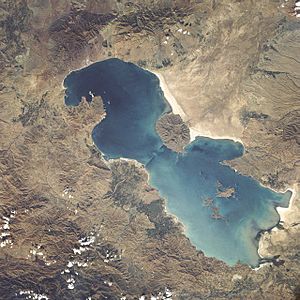Lake Urmia facts for kids
Quick facts for kids Lake Urmia |
|
|---|---|

from space, 1984
|
|
| Location | Iran |
| Coordinates | 37°42′N 45°19′E / 37.700°N 45.317°E |
| Type | Salt lake |
| Primary outflows | evaporation |
| Basin countries | Iran |
| Max. length | 140 km (87 mi) |
| Max. width | 55 km (34 mi) |
| Surface area | 5,200 km2 (2,000 sq mi) |
| Max. depth | 16 m (52 ft) |
| Islands | 102 |
Lake Urmia (Persian: دریاچه ارومیه) is a salt lake in northwest of Iran. It is in the provinces of East Azarbaijan and West Azarbaijan, and is southwest of the close shaped Caspian Sea. It is the largest lake inside Iran, and the second biggest salt lake of the world. It is the largest lake in the Middle East.
The location of Lake Urmia is at . It has a surface area of about 5,200 km² (2,000 mile²). At its biggest extent, it is about 140 km (87 miles) long, and 55 km (34 miles) wide. Its deepest point is approximately 16 m (52 ft) deep. It receives water from thirteen rivers coming from the near mountains, and it has no output.
Lake Urmia lies between West Azarbaijan and East Azarbaijan provinces. Tabriz is the biggest city to its east, and Urmia is the biggest city to its west. The shortest way between these cities is to go round the lake. In 1970s a project was started to create a bridge across the lake. This project was canceled when Islamic Revolution happened in 1979. However, the project was started again in 2000s; it is planned to be finished by the end of 2007.
The lake has a very salty water. The concentration of salt is different in each season of the year; it may be 26-28% in the late Autumn.
Lake Urmia is getting smaller and smaller each year. This is because the rivers which bring water to it have become smaller.
History
This lake was historically named Chaychast (Persian: چیچست). Later, it was named Urmia by the Assyrian people. The word Urmia consists of two parts: ur means city and mia means water. Urmia was the name given to the city of Urmia, which is near this lake. The lake was then named Lake Urmia, after the name given to the city. In the early years of the 20th century, it was named Rezaiyeh Lake after the name of Reza Pahlavi, the king of Iran. After the Islamic Revolution, its name was changed back to Urmia Lake.
Life near Lake Urmia
Different creatures live inside or near this lake, including some species of shrimps, amphibians and birds like flamingos and pelicans.
Urmia Lake has shallow borders with lots of mud. Different creatures live inside the mud, including frogs, snails and worms. The mud is said to have good effects in treatment of some diseases of the joints.
Islands
Lake Urmia has 102 islands. Their names are as follows :
Aram, Arash, Ardeshir, Arezu, Ashk, Ashk-Sar, Ashku, Atash, Azar, Azin, Bahram, Bard, Bardak, Bardin, Bastvar, Bon, Bon-Ashk, Borz, Borzin, Borzu, Chak-Tappeh, Cheshmeh-Kenar, Dey, Espir, Espirak, Espiro, Garivak, Giv, Golgun, Gordeh, Gorz, Iran-Nezhad, Jodarreh, Jovin, Jowzar, Kabudan, Kafchehnok, Kakayi-e Bala, Kakayi-ye Miyaneh, Kakayi-e Pain, Kalsang, Kam, Kaman, Kameh, Kariveh, Karkas, Kaveh, Kazem-Dashi, Kenarak, Khersak, Kuchek-Tappeh, Magh, Mahdis, Mahvar, Markid, Mehr, Mehran, Mehrdad, Meshkin, Meydan, Miyaneh, Nadid, Nahan, Nahid, Nahoft, Nakhoda, Navi, Naviyan, Omid, Panah, Penhan, Pishva, Sahran, Samani, Sangan, Sangu, Sarijeh, Sepid, Shabdiz, Shahi (Eslami), Shahin, Shamshiran, Shur-Tappeh, Shush-Tappeh, Siyavash, Siyah-Sang, Siyah-Tappeh, Sorkh, Sorush, Tak, Takht, Takhtan, Tanjeh, Tanjak, Tashbal, Tir, Tus, Zagh, Zar-Kaman, Zarkanak, Zar-Tappeh, Zirabeh.
Related pages
Images for kids
-
On holidays People come to see Lake Urmia around the "Shahid Kalantari" highway that still has water. The 15 km Shahid Kalantari highway is constructed by drying 85% of the boundary between the western-eastern sides of the lake. Construction of the highway has caused the northern and southern half disconnected and has made natural and fundamental changes in the hydrodynamic and ecological characteristics of the lake region.
See also
 In Spanish: Lago Urmía para niños
In Spanish: Lago Urmía para niños






